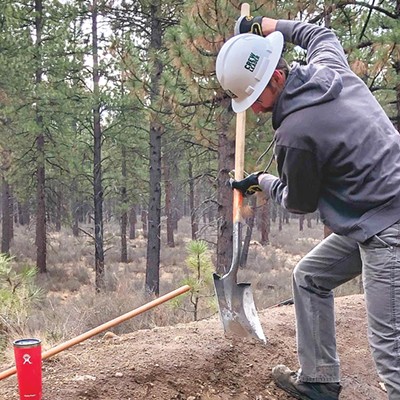In the predawn hours of July 28, a cool night with a quarter moon shining, a small band of activists cut through a chicken wire fence. They were there to release thousands of minks from their cages at a mink farm in south-central Idaho.
An anonymous communiqué published subsequently on the Earth First! Newswire blog details what happened next: "Illuminated in the moonlight, 2,400 of these wild creatures climbed out of the cages where they had passed their entire lives in isolated darkness, to feel the grass under their feet for the first time. Their initial timidity quickly became a cacophony of gleeful squealing, playing, cavorting, and swimming in the creek that runs directly behind the Moyle property."
It was one of a smattering of eco-sabotage incidents in recent months. Earth First!, founded in 1980, was a notorious and loosely organized band of eco-activists in the '80s and '90s that spawned the first tree sits and helped give rise to the more extreme Earth Liberation Front, a hard-line movement that included isolated pockets of eco-saboteurs who eventually claimed responsibility for various arsons against ski resorts, research farms and lumber mills. But, for the past decade, the group has largely been silent in the Pacific Northwest.
The recent Earth First! post goes on to explain that the farm owner, Cindy Moyle, current board member and former treasurer of the Fur Commission USA, runs "a mink dynasty in Idaho" and claimed victory, saying saboteurs set back that family's fur business by decades. Ultimately, 90 percent of the minks were recaptured, but still the farm claims to have suffered roughly $500,000 in damages.
But while the eco-saboteurs celebrated what they claimed was a setback to the fur industry, Michael Whelan, executive director of Fur Commission USA, fired back with an even more emotionally and legally charged word to describe the activists: He called their actions "terrorism."
Like a reissue of Nirvana or a remake of Fight Club, a recent smattering of clandestine environmentally-concerned actions has been eerily reminiscent of the '90s and early '00s heydays of eco-terrorism, when logging trucks were firebombed on Mount Hood, an Oakridge ranger station burned to its foundation and dozens of SUVs were torched in Eugene, actions all claimed by the ELF, an Earth First! offshoot.
Earlier this summer, in Ashland, 6,500 genetically engineered sugar beets were destroyed near Ashland on land leased and managed by Syngenta, a Swiss-based global agriculture corporation. The FBI quickly labeled the vandalism "economic sabotage" and a $10,000 reward was posted for information leading to the identification and arrest of anyone involved. For the first time since 9/11, these few incidents in the Pacific Northwest have bubbled Earth First!, the ELF and other eco warriors back to the public attention. After a decade of silence, the recent actions has federal agents and activists asking, is eco-terrorism back?
It started in 1985 when Mike Jakubal and Ron Huber, both rock climbers and environmentalists, scaled a Douglas fir in the Willamette National Forest, a swath of land on the western shadow of the Three Sisters and Broken Top. By occupying the tree, they took the gamble that loggers wouldn't chop it down. They planned to protect an area slated for clear-cutting.
Jakubal was quickly removed and arrested the same day he ascended the tree. But Huber proved more tenacious; like a tick embedded in a dog's fur, he nestled into the tree tops for two weeks. It is the first known U.S. tree sit, and went on to inspire an entire generation: A decade later, Julia Butterfly Hill, took up residence for 738 days, from '97 to '99, in a Redwood tree she called Luna; her occupation attracted worldwide attention and hundreds of newspaper and magazine articles—and, more importantly, stopped a plot of century-old California Redwoods in Humboldt County from being chopped down.
Those actions—and their successes—inspired more: In July 2000, Tre Arrow, a scrappy transient from Florida, born Michael Scarpitti, scrambled onto an second-story, 18-inch ledge in Portland, at the building housing the U.S. Forest Service. For 11 days he held court and brought public attention to a controversial logging sale on the flank of Mount Hood. His fame grew so much that the Green Party supported him as a candidate for U.S. House of Representatives against Earl Blumenauer in the 2000 elections. Although he lost that bid, Arrow remained in the public eye, taking to his own weeklong tree sit in the Tillamook State Forest, an action that ended in a standoff with loggers, who blasted him with music and lights to deprive him of sleep. Eventually, Arrow was quite literally shaken from the hemlock tree he was occupying and fell nearly 100 feet.
While such actions straddle the line between legal and illelage (often falling on the side of illegal), other environmentalists were crossing over to more direct and violent means, including Arrow himself. While running for office Arrow recruited three Portland State students to help him set fire to two logging trucks and a front-loading tractor near Mount Hood. On Easter morning 2001, the four firebombed three cement trucks at Portland's Ross Island Sand & Gravel. Placed on the FBI's Most Wanted list, Arrow fled to Canada, where he was arrested for shoplifting in Victoria in 2004 and eventually, in 2008, sentenced in the U.S. to 78 months in federal prison.
While eco-terrorists certainly operated throughout the U.S. during the late '80s and '90s, the spiritual home of the movement was Eugene. Michael Curry's excellent 2011 documentary, If A Tree Falls, a finalist for the Academy Award, chronicles how several fervent environmental activists, increasingly disillusioned with letter-writing and sit-ins, hardened into arsonists and vandals, and how those first tree sits led to more direct and destructive actions, like in 1996, when the ELF burned down an Oakridge Ranger Station 40 miles east by southeast from Eugene and near Jakubal's first tree sit; and in 2000, when a couple 20-somethings torched SUVs parked at a Eugene car dealership; and in 2001, when trees erroneously thought to be genetically modified, were destroyed at a tree farm near Astoria. With increasing fury, those years were a rambunctious era for eco and animal rights terrorists in Oregon—and Central Oregon certainly was not exempt. In 1997, Redmond arsonists burned down the Cavel West meat packing plant, a horse slaughtering factory. Months later, fire ripped through a Bureau of Land Management barn and 400 horses were released into the wild. The ELF and the Animal Liberation Front proudly claimed responsibility. In 1999 activists toppled an 80-foot tall transmission tower in Bend.
But by the turn of the century, the "movement" seems to have burned itself out. Some claim the increasingly violent and criminal activities were sobering to activists. And then there was 9/11, when expressing political desires through violent and destructive means collided with a new attitude of public and legal intolerance for anything in the neighborhood of "terrorism."
During those wild years, Craig Rosebraugh was spokesman of the Earth Liberation Front. He remembers them well. At the time, he was a lanky vegan with round glasses and prominent Adam's apple; he would often appear before the media to relay anonymous communiqués from ELF/ALF actions. In 1998, The New York Times labeled him the "Face of Ecoterrorism." The FBI raided his home several times, seizing computers and documents.
Now 41, Rosebraugh has gained weight and, although he still holds a zeal for environmentalism, expresses his political views through more traditional means. This spring, he released Greedy Lying Bastards, a documentary that investigates the heavy hand of the fossil fuel industry.
"There was a lot of activity in the late '90s," says Rosebraugh in a recent interview with the Source.
"In blockades, tree sits—it was a hotbed," recalls Rosebraugh, of the robust Northwest movement. "It was the rise of eco-sabotage."
The most damaging and frightening attack (though not in the Northwest) occurred in October 1998, when a partially built development at Vail Ski Resort was torched. In all five buildings and four chair lifts were destroyed, in the name of reclaiming critical lynx habitat. The arsons caused more than $12 million in damages. ELF proudly claimed responsibility.
"It reached a peak in 2001," recalls Rosebraugh. In the face of severe penalties and long prison sentences, would-be ecoterrorists had second thoughts. It was the start of the so-called Green Scare.
"Nobody wanted to be labeled a terrorist," says Rosebraugh of the dropoff in illegal actions.
Such insights are confirmed by Assistant U.S. Attorney Steven Peifer, who prosecuted Tre Arrow in 2008.
"Law enforcement has been very effective," adds Peifer. "I think there's a fear of long prison sentences. People are recognizing that this doesn't pay. Also, there's a fear of not trusting your co-conspirator." (In the Arrow case, one of the former ecoterrorists eventually testified against his co-conspirators in a plea agreement.)
A specialist in violent crimes, especially those related to domestic terrorism, Peifer outlines the broad definition that the federal government now uses to include a wide number of crimes within the damning term of "terrorism," explaining that it "is when you use violence to achieve a political, social or economic purpose." For example, recent acts like damaging property to release minks into the wild or destroying a beet farm—both of which caused considerable economic damage—could be swept into the definition. And those acts can carry multiear sentences, often enhanced by the very whiff of the word terrorist.
Occupy this future
Even so, recently there have been noticeable stirrings and shifts in the political climate. Looking at the tea leaves, such developments easily could be interpreted as a trend back toward an era of outspoken political activism, which, if history teaches anything, often flares into more violent and direct acts.
The first stirring came in 2008, when after seven years of silence, ELF relaunched its press offices, this time without Rosebraugh. In the seven years after Sept. 11, 2001, public opinion had calmed; ELF peaking out its head was one of the first indicators that it may be safe—or at least safer—for environmental activists to return to more direct actions.
Then, on Sept. 17, 2011, after a decade of relative calm as far as major political protests are concerned, a few dozen protesters filed into New York City's Zuccottii Park, near Wall Street. The action—a scattered statement about banks' greed and unequal wealth distribution—quickly inspired similar activities in dozens of cities across the nation. From New York City to L.A., and dozens of cities in between, similar "Occupy" street protests took root; perhaps the most violent occurred in Oakland, where hundreds of protestors scuffled with police and, at one point, stormed City Hall.
While not directly attached to environmental concerns (like the World Trade Organization street protests in Seattle that closed out the last century), the Occupy protests did exhibit something not seen for a while—massive and widespread public frustration over public policy, and expressed in a manner that wasn't fearful of police crackdowns or legal consequences.
Just as indicative, a number of celebrities have begun stepping up in their political expressions—especially concerning issues near and dear to environmentalists. And just as celebrities' hairstyles and beverage choices can influence mainstream behavior, so can their political activism.
Last summer, for example, the aptly named actress Lucy Lawless (aka Xena, Warrior Princess) jumped on board a Greenpeace action; she was arrested after clambering to the top of an oil drilling ship in protest of an Artic oil exploration. Likewise, actress Daryl Hannah (Blade Runner, Kill Bill), was arrested at the White House for protesting the proposed Canadian-U.S. Keystone Pipeline, a controversial oil transport system that could disrupt ecosystems from Eastern Alberta to Eastern Texas. And, just last month, Natalie Hynde, daughter of spunky Pretenders lead singer Chrissie Hynde, grabbed international headlines by gluing herself to a fellow protestor to create a human lock near the entrance for a fracking site in southern England. She was joined by human rights activist Bianca Jagger (Mick's former wife).
Particularly interesting, this summer Scott Free Productions released The East, a big-budget film about the infiltration of an eco-activist group. Slowly, the female protagonist, a government agent sent to spy on a group of would-be corporate saboteurs, departs from her mission and warms to their ideas and ideals; the activists and saboteurs are not vilified but presented as charismatic and rational activists. Just as the first season of the popular TV show Homeland justifies the central character's terrorism—as a returning prisoner of war radicalized by the death of an Afghan child by a drone strike—such portrayals go a long way toward humanizing and creating sympathy for the bad guy.
And these are not only fictional accounts, or hypothetical assertions. In the years after the September 11 attacks, every major city in America (besides Portland) adopted a Joint Terrorism Task Force, an agreement among federal agents and local police officers to share surveillance of political activists, often with little oversight. (Portland City Council refused to ratify the agreement after the FBI refused to provide access to the majority of information it was compiling.)
But increasingly, such surveillance in the name of security has overstepped public opinion. In 2008, JTTF officers in the Twin Cities infiltrated local college students and young social activists in the hope of disrupting any protests against the Republican National Convention held in St. Paul late that summer. Those infiltrations led to loud complaints and lawsuits; really, it was the first whimpering that civil liberties and privacy issues were being overrun by heavy-handed police actions, a sentiment that grew to a roar this summer as the cases of Bradley Manning and Edward Snowden highlighted legally questionable information-gathering practices carried out by the National Security Agency.
And that is part of the culminating perfect storm, the potential combination of political disgruntlement brewing in an environment that favors secrecy and privacy; these are the very elements necessary to come together for an eco-sabotage revival.
A July Pew Research Center poll revealed that, for the first time since 2004, a majority of Americans are more concerned about civil liberties than national security. Even Congressman Jim Sensenbrenner (R-Wis.), an official who helped introduce the Patriot Act in 2001, has said the NSA, with its collections of phone-record particulars and social media-monitoring PRISM programs, has gone too far. Sen. Ron Wyden (D-Ore.), a privacy proponent and one of the most outspoken critics of the Patriot Act's current wording, is also pushing for reform.
Closer to home
In early June, the Source received a lengthy letter to the editor, which was published in our June 6 issue. Titled, "Notice: Popular Recreation Forest Near Bend Slated for Logging," the letter outlined "the Forest Service's extreme logging proposal for the forest just west of Bend along Skyliners Road and Century Drive toward Mt. Bachelor," and referred to the proposed thinning project as a "virtual clear cut."
"The Forest Service is likely to gut this beautiful large area of public forest and greatly degrade its value for wildlife and recreationalists without significant public outcry," the letter concludes.
Karen Coulter, executive director of the Blue Mountain Biodiversity Project, penned the passionate note. While she explicitly says she would not undertake eco-sabotage, she expresses sympathy for such actions.
Long a supporter of Earth First!, Coulter, 55, fondly recalls being involved in acts of civil disobedience in the '80s and '90s, and while she says she wasn't involved on the front lines, she still supports direct-action campaigns.
"I remember how vibrant that movement was," says Coulter. She cites the Cascadia Forest Defenders as a group that continues to carry the torch. (According to its website, the group is currently involved in a tree sit campaign in Southern Oregon).
These days, Coulter's concerns extend beyond the forests and deserts of Central Oregon.
"I'm very concerned about this country becoming some kind of dictatorship," Coulter says, referring to what she calls the "repressive laws" that followed in the wake of the September 11 attacks and resulted in extended prison sentences for eco-saboteurs.
On the surface, Coulter's low-tech life near Fossil, Ore.—one that doesn't include a cellphone or even electricity—may seem fringe or even extreme ("I think better when not surrounded with so much electromagnetic activity," she says), but her fears are relatable.
Could such distrust and public pushback lead to a lengthening of the privacy leash? Maybe.
Might that in turn trigger a renewed interest in direct action?
"I would hope so," Coulter concludes.

























